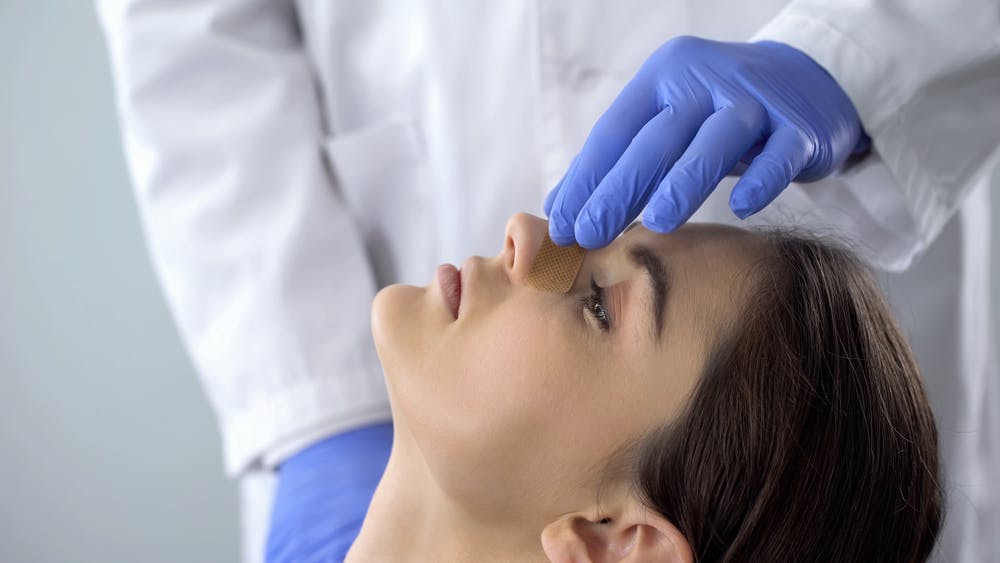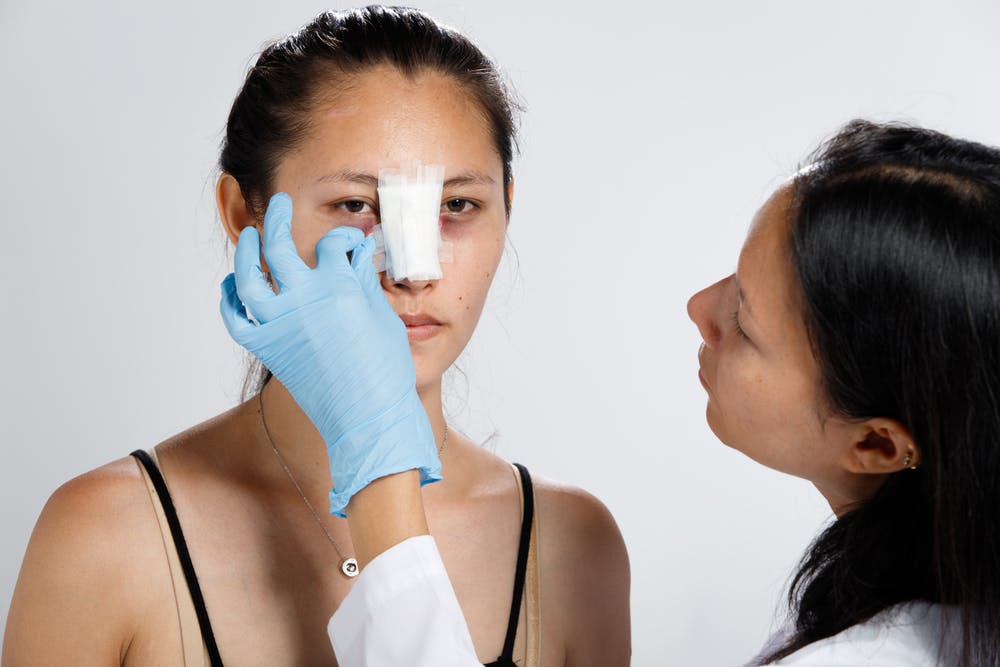
Revision rhinoplasty, a procedure designed to correct and refine results from previous nasal surgeries, can often result in significant post-operative swelling. This swelling is a normal part of the healing process, but it can cause discomfort and anxiety for patients.
Understanding the timeline and stages of swelling can help alleviate these concerns and aid in a smoother recovery process.
Understanding Post-Revision Rhinoplasty Swelling
Revision rhinoplasty swelling is an integral part of the body’s healing process and is quite common. It begins immediately after surgery during the inflammatory phase of healing and can last an additional one to six days. This is followed by the proliferative phase, which typically lasts between one and six weeks post-surgery.
The final stage of the healing process, known as the remodeling phase, can last from six months to one year. It is essential for patients to understand that swelling is a normal part of the revision rhinoplasty recovery process and to be patient as the body heals.

Factors Influencing Swelling Post-Revision Rhinoplasty
The extent and duration of swelling following revision rhinoplasty can be influenced by a myriad of factors.
Skill and Experience of the Surgeon
The skill and technique of the revision rhinoplasty surgeon can significantly impact the rhinoplasty recovery process. The surgeon’s artistic skill and understanding of nasal anatomy are crucial in performing the procedure with minimal trauma to the soft tissues, therefore reducing post-operative swelling.
Surgical Technique: Open vs. Closed
The choice between an open versus closed approach to revision rhinoplasty procedures also plays a role. An open approach may involve more extensive nasal reconstruction, potentially leading to more swelling.
On the other hand, a closed approach, while less invasive, may not provide the same level of access for the surgeon to correct complex issues from the initial surgery.
Role of Nasal Bone Modification
Whether the nasal bones were broken during the revision surgery is another factor. Breaking and repositioning the nasal bones, a technique often used to alter the nose shape, can lead to increased swelling.
Prior Surgeries
The number of prior nasal surgeries can also impact the swelling after revision rhinoplasty. Each additional surgery can lead to more scar tissue, which can complicate the revision procedure and potentially lead to more swelling.
Structural Grafts
The use of structural grafts, such as bilateral spreader grafts or crural strut grafts, can also contribute to post-operative swelling. Structural grafting, while essential for maintaining nasal function and structure, can cause additional trauma to the nasal tissues.
Individual Health and Lifestyle Factors
Individual factors, such as the patient’s overall health, lifestyle habits, and adherence to post-operative care instructions, also significantly impact the swelling and overall rhinoplasty recovery process.

Immediate Post-Operative Swelling: Early Management
Managing swelling in the immediate post-operative period is crucial for a smooth recovery and optimal outcomes. Patients are advised to rest for the first 48 hours following surgery, avoid smoking and alcohol, and stay well-hydrated. Sleeping upright at a 30-degree angle or on several pillows for the first two to three weeks can also help minimize swelling.
In addition, applying ice packs or frozen peas to the area can be beneficial in the first few days following surgery. It’s important to note that while the swelling may be noticeable, it is a normal part of the healing process and will gradually subside over time.
Navigating Early Recovery: Swelling Reduction Techniques

During the early recovery stage, typically 1-2 weeks after surgery, patients will notice a significant reduction in swelling. This is due to the healing process and the patient’s adherence to the post-operative care instructions. To further reduce swelling, patients are advised to avoid strenuous activities and limit physical activity.
Patients can use a saline nasal spray to keep the nasal tissues moist and reduce nasal congestion. It’s also beneficial to continue sleeping with the head elevated and apply ice packs as needed.
Mid-Term Swelling Management: Weeks to Months
In the weeks and months following revision rhinoplasty, patients will continue to see a reduction in swelling. During this recovery period, the patient’s nose will begin to reveal its new shape, although it may still appear swollen to the patient.
This is a normal part of the healing process, and patients should continue to follow their surgeon’s advice about revision rhinoplasty recovery. It includes avoiding strenuous exercise, maintaining a healthy diet, and keeping follow-up appointments with the revision nose surgeon.
Long-Term Swelling and Timelines: Anticipated Resolution
The resolution of swelling after revision rhinoplasty is a gradual process that can take up to 9–12 months. During this time, the patient’s nose will continue to refine and take on its final form.
It’s important for patients to have realistic expectations and understand that the final results will not be visible until the residual revision rhinoplasty swelling has completely resolved. Patients should continue to follow their surgeon’s post-operative instructions and maintain a healthy lifestyle to support the healing process.

Effective Swelling Management: Expert Recommendations
To effectively manage swelling after revision rhinoplasty, experts recommend following a few key steps.
- Patients should adhere to their surgeon’s aftercare instructions, which may include taking prescribed medications, applying a layer of ointment to the nasal tissues, and avoiding demanding activities.
- Patients should maintain a healthy lifestyle, including a diet rich in fruits and vegetables and low in salty foods, which can increase fluid retention and exacerbate swelling.
- Patients should keep all follow-up appointments with their surgeon to monitor their progress and address any concerns promptly.
Addressing Persistent Swelling: When to Seek Guidance

In some cases, patients may experience persistent swelling after revision rhinoplasty. This can be a sign of complications, such as infection or a tissue reaction. If swelling persists beyond the expected recovery timeline, it is crucial to seek guidance from your surgeon. They can assess your situation, identify any potential issues, and provide appropriate treatment.
Remember, each patient’s healing process is unique, and it’s essential to maintain open communication with your surgeon throughout the recovery process.
Holistic Recovery Approach: Beyond Swelling Management
While managing swelling is a crucial part of recovery, it’s equally important to adopt a holistic approach to your overall health and well-being. A holistic approach can enhance your body’s healing process, reduce potential complications, and contribute to the successful revision of rhinoplasty results.
Optimizing Swelling Management in Revision Rhinoplasty
Optimizing swelling management involves a combination of following your surgeon’s instructions, maintaining a healthy lifestyle, and being patient with your body’s healing process. It’s important to remember that healing takes time, and the final results of your revision rhinoplasty will not be visible until all the swelling has completely resolved.
Stay committed to your recovery plan, keep your follow-up appointments, and communicate openly with your surgeon. This will ensure you are on the right track to achieving a balanced and natural-looking facial appearance. Schedule a consultation with Glasgold Group experts and ensure a safe and smooth recovery after a revision rhinoplasty.



